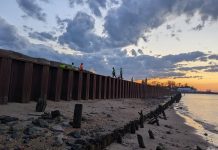By John Burton
Contractors for the state Department of Environmental Protection (DEP) will be in the area, beginning March 4, to clean up tons of debris washed into waterways by Super Storm Sandy.
“We know there is a lot in the water, a lot along the water’s edge, a lot in the places that used to be where water was,” said DEP spokesman Lawrence Ragonese.
The DEP has contracted with a number of companies to work on cleaning the area waters, seeking to get 75 percent of this trash removed by June 1.
“The hope is we’ll have as close to a normal summer season as possible,” Ragonese said.
The DEP, working in partnership with the Federal Emergency Management Agency (FEMA), has hired five contractors to scout and remove Sandy-related debris from the water and surrounding areas. The DEP has sectioned off the state into a series of 11 zones from the state’s northern, central, and southern regions.
Monmouth County water comes under two zone designations. The state’s zone 2 in the northern region of the county begins at the Outerbridge Crossing and ends at the northern bank of the Navesink River. Zone 3, which has the bulk of the county’s waterways, includes the Monmouth County’s coastal tidal streams, all of the Navesink and its tributaries south to and including all of the Manasquan River, according to the DEP.
The contracts were awarded to: DonJon Marine, Hillside, which will be responsible for zones 1 and 2; and CrowderGulf Disaster Recovery and Debris Management, headquartered in Theodore, Ala., which will be responsible for most of the county’s waterways in zone 3.
“We are in unchartered waters here,” Ragonese said, acknowledging the pun, “because we never had to do this type of cleanup before.”
For the first 12 weeks following the October storm, efforts were focused on removing the incredible amount of debris from the streets and in front of people’s homes, with the DEP now concentrating its efforts on the water cleanup.
CrowderGulf is already on-site, training personnel and reviewing state requirements and maps, Ragonese said.
A CrowderGulf representative said in an email this week the company wouldn’t comment, as the actual work hasn’t begun. Calls placed to DonJon’s offices were not returned by press time.
Marcus Witkowski, commodore for the Atlantic Highlands Yacht Club, said he was concerned about the upcoming boating season.
“I’m going to tell you right now, it’s going to be a cautious time for the recreational boater,” he said.
Witkowski said the main problem isn’t what’s floating on top of the water but rather what has sunk and is unseen that’ll pose the most threat to watercraft.
“There were so many vessels lost,” he said. “There are so many docks and pilings that were torn loose, got waterlogged and floated out and sunk into susceptible areas.”
Ragonese acknowledged that what is underwater is an unknown at this point. “These companies that have been hired will be out there with sonar and other devices looking underwater,” along with scuba divers to search, he said.
The companies will be collecting what they find and documenting it for state and federal analysis. FEMA is only expected to pay for the removal of Sandy-related items, he said.
Over the next six to eight weeks more information will become available as to the extent of what is out there and being recovered. The DEP will keep commercial and recreational boaters informed about what is found and how the cleanup is progressing, Ragonese said.
“We hope to have as much of the waters cleaned as possible and we hope to have as close to normal a boating and fishing season as possible,” he said.
But it won’t be the same as it was last year, he acknowledged. “You have to understand Sandy struck and there are consequences,” Ragonese said. “So there will be some likely restrictions on certain areas on fishing and boating.”
Witkowski said there are other things boaters will have to take into account as they set sail this year, including the changing shoals with the shifting of sand by the storm.
“Some of the waterways that were there last year are not going to be there this year,” he said. “There may be new waterways this year.”
Another issue, he said, is the displacement of both the federal and privately controlled aids to navigation, referred to as ATON. These are a sort of buoy or marker that help boaters make their way. Witkowski, who also serves with the U.S. Coast Guard Auxiliary, said many of these, especially the privately owned ones, were likely knocked out of their usual locations, creating a potential hazard.
“It’ll probably cause quite a few groundings,” he said with a sigh. “It’s going to be a real challenge this year.”














